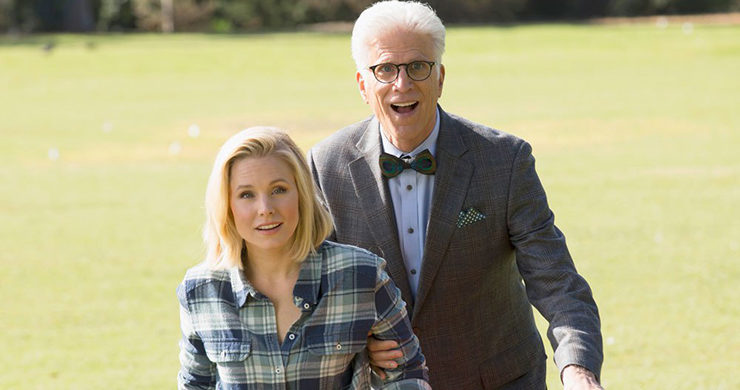If you haven’t seen it, NBC’s The Good Place is a (Hugo Award winning!) fantasy sit-com about Eleanor Shellstrop (Kristen Bell), a morally mediocre (at best) woman who dies and finds herself in a sort-of heaven called the Good Place. Figuring that someone somehow made a cosmic mistake, Eleanor tries to learn how to be good before the Good Place’s architect Michael (Ted Danson) finds out and sends her to the Bad Place.
(If you have seen it, you’ll notice this article does its level best to avoid spoiling the wilder twists, but if you know, then you know.)
The central question of the show is can Eleanor, and more generally can anybody, change their basic morality? Is personal growth possible, or is one’s essential morality fixed? This is an old question, explored throughout science, philosophy, religion, and literature in every different genre and format, and I cannot think of a worse way to answer this question than with a sit-com, because, as a rule, sit-com characters do not change.
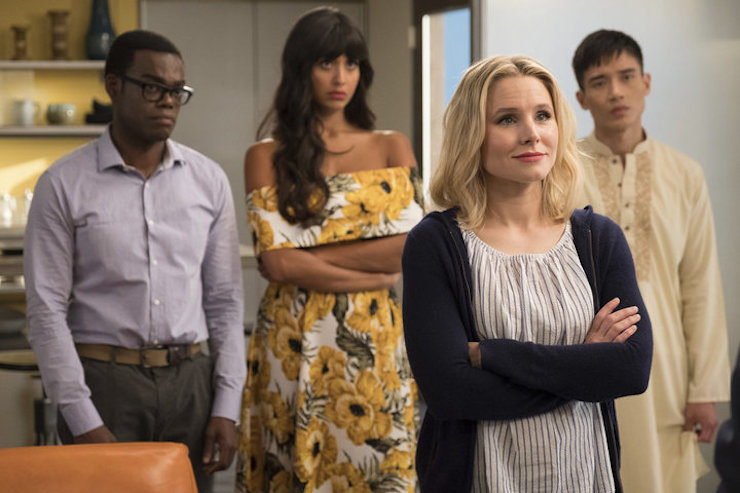
I don’t mean that as a criticism. Static characters are people you know. They are familiar, comfortable. Sit-coms can run for decades precisely because the characters remain essentially the same year after year. The circumstances may change, they get new jobs, get married, have kids, die—but none of these experiences really change anyone. Sam Malone is a charming if cynical bartender in the first season of Cheers and, despite everything, he’s still that eleven years later, and that’s great. Sometimes you want to go where you know everybody’s name.
And that’s the trick of The Good Place: the Good Place, the place itself, is a sit-com. It’s a lot of nice people living in a brightly colored simulacrum of the real world where there are no real problems and no real consequences. Drop a dumpster on someone? It’s fine, no one can die in heaven. Or get hurt. Eleanor can’t even swear, no matter how much she wants to, as some celestial version of Standards and Practices replaces her cusses with “fork,” “shirt,” and “ash-hole”. (The idea that the Good Place is a sit-com, and architect Michael is its showrunner, is further reinforced in season 2, when Michael starts tinkering with the Good Place after getting notes from his superiors, and his assistant starts angling for a bigger role.)
Like the frozen yogurt that populates most of its stores, the setting is an uncanny reproduction of something familiar. The cinematography highlights how short the streets are, because it’s shot on the Universal backlot just a stone’s throw from the Jurassic Park ride. The geography of the Good Place defies mapping. There’s the town square, a mansion, a lake, a train station, a beach, but no sense of how these things fit together. And that’s before getting to the truly fantastic images of people flying, giraffes rampaging through town, helpful assistants popping out of thin air, and a dog kicked into the sun. Everything exists to remind Eleanor and the viewer that this utopia is no place at all.
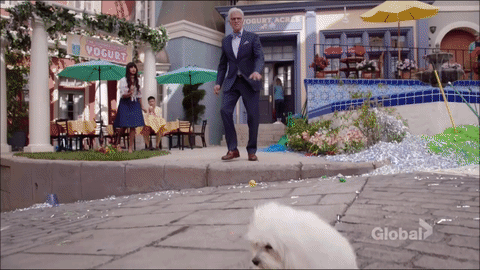
And without real problems to confront or even a reality she can trust in, Eleanor is trapped in a sit-com version of Limbo, where there’s no punishment for her sins and not much reward for her virtues. Michael explains that one’s morality score is locked in when one dies, which means that even if Eleanor does change for the better, the Good Place would simply discount it.
This gets at one of the central ironies of sit-coms: the characters don’t grow despite constantly learning important lessons at the end of each episode. Characters can learn to be brave, or care, or trust—they can appear to grow, but when the next episode starts, all the growth has been wiped away and it’s somebody else’s turn to carry the idiot ball.
Thus, in order to grow, Eleanor must overcome her own personal flaws, and the rules of the Good Place, and the sit-com format of The Good Place, where the creators can’t let her earn her place in heaven or else the show ends. By the second season finale, it’s far from certain if Eleanor can ever really improve, or if she’ll just eternally elude eternal punishment.
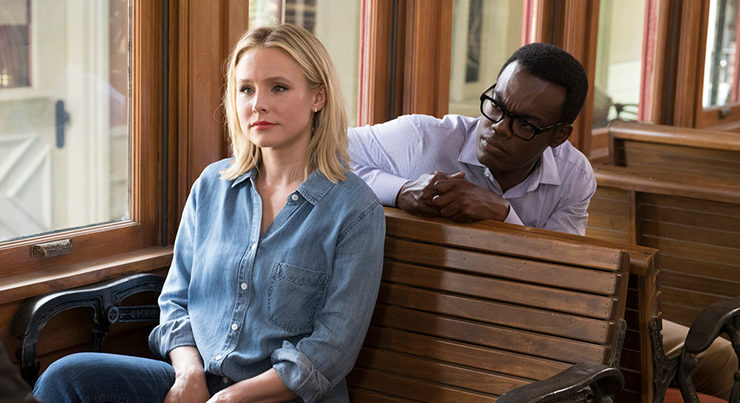
To the larger question of whether a person can change, however, the show gives a definitive, “Yes.” Eleanor does overcome her own flaws, does begin to make altruistic choices rather than selfish ones. It’s not easy, it’s not always forward progress, and the rewards are not great, but with support, guidance, and inspiration from the people around her, Eleanor shows signs of improvement. It’s the supernatural forces around her, the ones committed to keeping her and everyone in the Good Place where they are, that she has more trouble with. It’s the artificial, external constraints that keep Eleanor static, nothing intrinsic at all.
It’s not surprising that The Good Place portrays personal growth as possible in a sit-com, because the two other shows created by Michael Schur, Brooklyn Nine-Nine and Parks and Recreation, also feature characters that break the rule about sit-com characters remaining static. On Brooklyn Nine-Nine, Detective Jake Peralta starts out treating police work as a game; by season 5, however, he’s acutely aware that he can ruin people’s lives if he’s careless. And on Parks and Rec, April Ludgate goes from uninterested sullen intern to hyper passionate activist and wife. In both cases, the changes happen incrementally, reflect the people who surround them, and pointedly, are unique. Jake grows, but Captain Holt doesn’t. April grows, but Leslie Knope doesn’t. Not everyone can change, or needs to, but some people absolutely can.
The Good Place’s optimistic message that anyone can improve is also Michael Schur’s challenge to other sit-com writers: hey, the only thing keeping your characters stuck in place is you. If you develop your characters, let them actually learn from their mistakes and grow, your characters and your story will go in wild and wonderful directions.
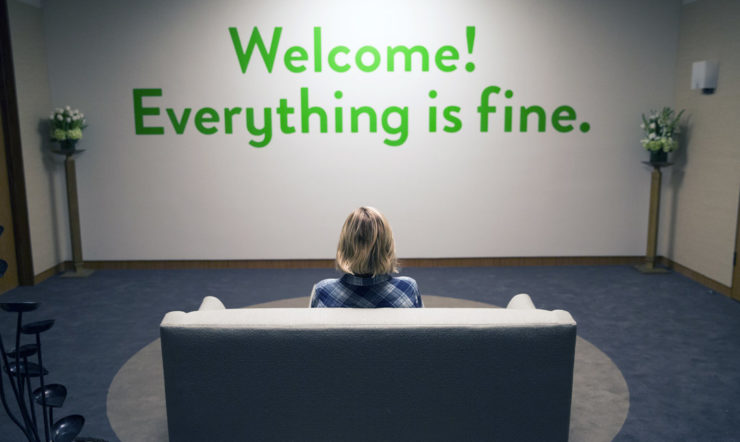
Like his namesake, the architect Michael created a world that’s usually eternally static, then added a woman who stubbornly refuses to repeat her mistakes. Eleanor’s growth is as entertaining as it is chaotic—it’s entertaining precisely because it is chaotic. As Eleanor stumbles and learns and grows in ways Michael can’t anticipate, edging closer to deserving her place in heaven (and thus the end of the show), the Good Place literally breaks down around her. Her post-mortem growth threatens to undo Michael’s Good Place and the whole system that creates Good Places—both the system that judges souls within the show, and the way sit-coms in general are made.
As the source of so much creative destruction, it’s probably not a coincidence that Eleanor means “Bringer of Light.”
Originally published in June 2018.
Steven Padnick is a freelance writer and editor. By day. You can find more of his writing and funny pictures at padnick.tumblr.com.










